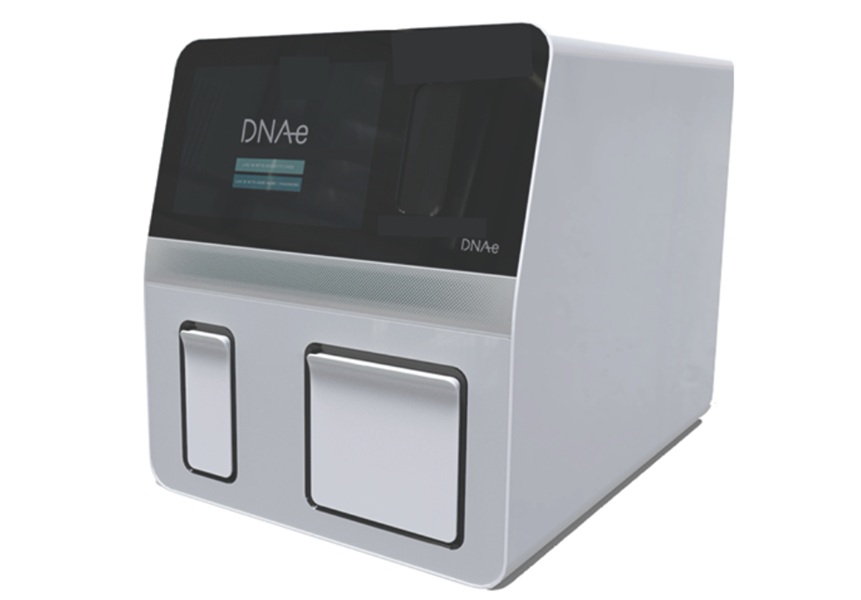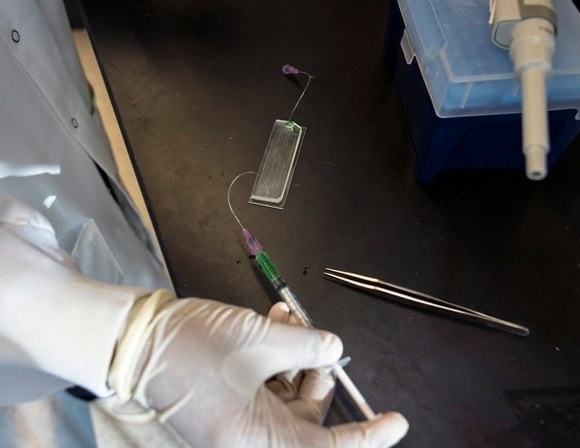Membrane-Bound Enzyme Linked to Plaque Formation in Mouse Atherosclerosis Model
|
By LabMedica International staff writers Posted on 21 Jul 2015 |

Image: Results presented in this study suggest that the enzyme CD39 can suppress the plaque buildup that may trigger heart attack or stroke (Photo courtesy of the University of Michigan).
Cardiac disease researchers working with a mouse model of atherosclerosis have found that that a specific membrane bound enzyme has the potential to inhibit build-up of plaque and reduce risk of heart attack or stroke.
Investigators at the University of Michigan (Ann Arbor, USA) worked with the apolipoprotein E-deficient (ApoE-deficient) mouse model of atherosclerosis to examine the role of the enzyme CD39 (ectonucleotide tri(di)phosphohydrolase-1 or ENTPD1) in the process of plaque formation. This enzyme metabolizes locally released, intravascular ATP and ADP, thereby eliminating these pro-thrombotic and pro-inflammatory signaling molecules.
The investigators reported in the June 29, 2015, online edition of the Journal of Clinical Investigation that when animals fed a high-fat diet were compared, it was seen that ApoE-deficient mice that also lacked CD39 had a plaque burden that was markedly increased along with circulating markers of platelet activation. CD39 was prominently expressed in stable blood flow regions and was diminished in areas subjected to disturbed flow. Thus, CD39 activation followed the pattern of plaque formation.
In mice, disturbed blood flow as the result of partial carotid artery ligation rapidly suppressed endothelial CD39 expression. Moreover, unidirectional laminar shear stress induced protective CD39 expression in human endothelial cells.
“Better lifestyles and improved treatments have slowed the rates of death from atherosclerosis, but if CD39 proves to be as critical a factor in humans as in mice, it would be a major step forward in understanding heart disease,” said senior author Dr. David Pinsky, professor of cardiology at the University of Michigan.
Related Links:
University of Michigan
Investigators at the University of Michigan (Ann Arbor, USA) worked with the apolipoprotein E-deficient (ApoE-deficient) mouse model of atherosclerosis to examine the role of the enzyme CD39 (ectonucleotide tri(di)phosphohydrolase-1 or ENTPD1) in the process of plaque formation. This enzyme metabolizes locally released, intravascular ATP and ADP, thereby eliminating these pro-thrombotic and pro-inflammatory signaling molecules.
The investigators reported in the June 29, 2015, online edition of the Journal of Clinical Investigation that when animals fed a high-fat diet were compared, it was seen that ApoE-deficient mice that also lacked CD39 had a plaque burden that was markedly increased along with circulating markers of platelet activation. CD39 was prominently expressed in stable blood flow regions and was diminished in areas subjected to disturbed flow. Thus, CD39 activation followed the pattern of plaque formation.
In mice, disturbed blood flow as the result of partial carotid artery ligation rapidly suppressed endothelial CD39 expression. Moreover, unidirectional laminar shear stress induced protective CD39 expression in human endothelial cells.
“Better lifestyles and improved treatments have slowed the rates of death from atherosclerosis, but if CD39 proves to be as critical a factor in humans as in mice, it would be a major step forward in understanding heart disease,” said senior author Dr. David Pinsky, professor of cardiology at the University of Michigan.
Related Links:
University of Michigan
Latest BioResearch News
- Genome Analysis Predicts Likelihood of Neurodisability in Oxygen-Deprived Newborns
- Gene Panel Predicts Disease Progession for Patients with B-cell Lymphoma
- New Method Simplifies Preparation of Tumor Genomic DNA Libraries
- New Tool Developed for Diagnosis of Chronic HBV Infection
- Panel of Genetic Loci Accurately Predicts Risk of Developing Gout
- Disrupted TGFB Signaling Linked to Increased Cancer-Related Bacteria
- Gene Fusion Protein Proposed as Prostate Cancer Biomarker
- NIV Test to Diagnose and Monitor Vascular Complications in Diabetes
- Semen Exosome MicroRNA Proves Biomarker for Prostate Cancer
- Genetic Loci Link Plasma Lipid Levels to CVD Risk
- Newly Identified Gene Network Aids in Early Diagnosis of Autism Spectrum Disorder
- Link Confirmed between Living in Poverty and Developing Diseases
- Genomic Study Identifies Kidney Disease Loci in Type I Diabetes Patients
- Liquid Biopsy More Effective for Analyzing Tumor Drug Resistance Mutations
- New Liquid Biopsy Assay Reveals Host-Pathogen Interactions
- Method Developed for Enriching Trophoblast Population in Samples
Channels
Clinical Chemistry
view channel
Noninvasive Blood-Glucose Monitoring to Replace Finger Pricks for Diabetics
People with diabetes often need to measure their blood glucose multiple times a day, most commonly through finger-prick blood tests or implanted sensors. These methods can be painful, inconvenient, and... Read more
POC Breath Diagnostic System to Detect Pneumonia-Causing Pathogens
Pseudomonas aeruginosa is a major cause of hospital-acquired and ventilator-associated pneumonia, particularly in lung transplant recipients and patients with structural lung disease. Its ability to form... Read moreMolecular Diagnostics
view channel
World's First NGS-Based Diagnostic Platform Fully Automates Sample-To-Result Process Within Single Device
Rapid point-of-need diagnostics are of critical need, especially in the areas of infectious disease and cancer testing and monitoring. Now, a direct-from-specimen platform that performs genomic analysis... Read more
Rapid Diagnostic Breakthrough Simultaneously Detects Resistance and Virulence in Klebsiella Pneumoniae
Antibiotic resistance is a steadily escalating threat to global healthcare, making common infections harder to treat and increasing the risk of severe complications. One of the most concerning pathogens... Read moreHematology
view channel
MRD Tests Could Predict Survival in Leukemia Patients
Acute myeloid leukemia is an aggressive blood cancer that disrupts normal blood cell production and often relapses even after intensive treatment. Clinicians currently lack early, reliable markers to predict... Read more
Platelet Activity Blood Test in Middle Age Could Identify Early Alzheimer’s Risk
Early detection of Alzheimer’s disease remains one of the biggest unmet needs in neurology, particularly because the biological changes underlying the disorder begin decades before memory symptoms appear.... Read more
Microvesicles Measurement Could Detect Vascular Injury in Sickle Cell Disease Patients
Assessing disease severity in sickle cell disease (SCD) remains challenging, especially when trying to predict hemolysis, vascular injury, and risk of complications such as vaso-occlusive crises.... Read more
ADLM’s New Coagulation Testing Guidance to Improve Care for Patients on Blood Thinners
Direct oral anticoagulants (DOACs) are one of the most common types of blood thinners. Patients take them to prevent a host of complications that could arise from blood clotting, including stroke, deep... Read moreImmunology
view channel
Blood Test Could Identify Colon Cancer Patients to Benefit from NSAIDs
Colon cancer remains a major cause of cancer-related illness, with many patients facing relapse even after surgery and chemotherapy. Up to 40% of people with stage III disease experience recurrence, highlighting... Read moreBlood Test Could Detect Adverse Immunotherapy Effects
Immune checkpoint inhibitors have transformed cancer treatment, but they can also trigger serious immune-related adverse events that damage healthy organs and may become life-threatening if not detected early.... Read moreMicrobiology
view channel
New UTI Diagnosis Method Delivers Antibiotic Resistance Results 24 Hours Earlier
Urinary tract infections affect around 152 million people every year, making them one of the most common bacterial infections worldwide. In routine medical practice, diagnosis often relies on rapid urine... Read more
Breakthroughs in Microbial Analysis to Enhance Disease Prediction
Microorganisms shape human health, ecosystems, and the planet’s climate, yet identifying them and understanding how they are related remains a major scientific challenge. Even with modern DNA sequencing,... Read morePathology
view channel
AI Tool Simultaneously Identifies Genetic Mutations and Disease Type
Interpreting genetic test results remains a major challenge in modern medicine, particularly for rare and complex diseases. While existing tools can indicate whether a genetic mutation is harmful, they... Read more
Rapid Low-Cost Tests Can Prevent Child Deaths from Contaminated Medicinal Syrups
Medicinal syrups contaminated with toxic chemicals have caused the deaths of hundreds of children worldwide, exposing a critical gap in how these products are tested before reaching patients.... Read more
Tumor Signals in Saliva and Blood Enable Non-Invasive Monitoring of Head and Neck Cancer
Head and neck cancers are among the most aggressive malignancies worldwide, with nearly 900,000 new cases diagnosed each year. Monitoring these cancers for recurrence or relapse typically relies on tissue... Read moreTechnology
view channel
Diagnostic Chip Monitors Chemotherapy Effectiveness for Brain Cancer
Glioblastoma is one of the most aggressive and fatal brain cancers, with most patients surviving less than two years after diagnosis. Treatment is particularly challenging because the tumor infiltrates... Read more
Machine Learning Models Diagnose ALS Earlier Through Blood Biomarkers
Amyotrophic lateral sclerosis (ALS) is a rapidly progressive neurodegenerative disease that is notoriously difficult to diagnose in its early stages. Early symptoms often overlap with other neurological... Read moreIndustry
view channel
BD and Penn Institute Collaborate to Advance Immunotherapy through Flow Cytometry
BD (Becton, Dickinson and Company, Franklin Lakes, NJ, USA) has entered into a strategic collaboration with the Institute for Immunology and Immune Health (I3H, Philadelphia, PA, USA) at the University... Read more










 (3) (1).png)













